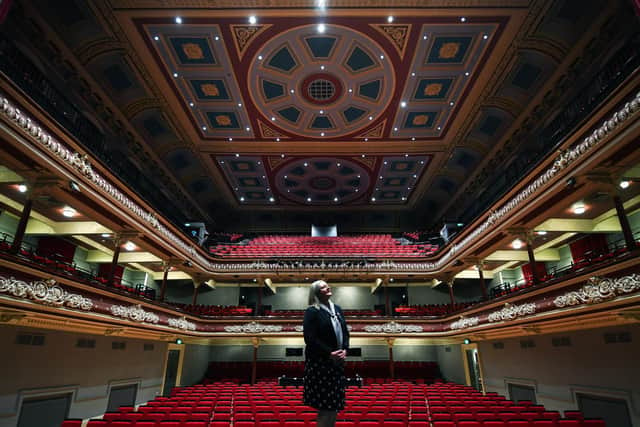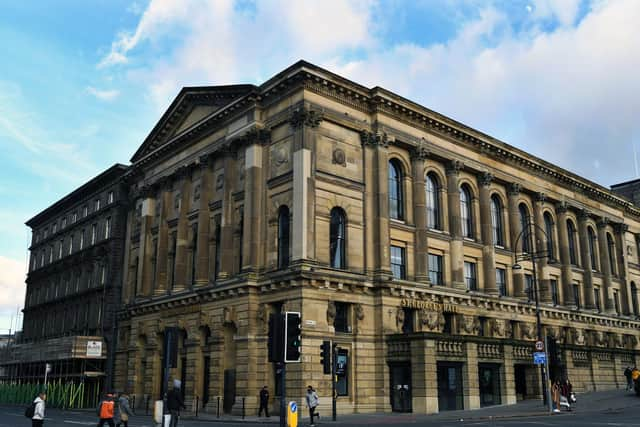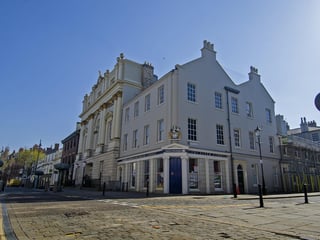From Charles Dickens to David Bowie - Bradford's St George's Hall has seen them all
He was the mayor at the time, and his name was Samuel Smith. He proposed that the town should build a “music hall”.
He wanted a place where the local townsfolk could listen to lectures and hear first class music performed by the leading artists of the day. And, naturally, they could also take their own home grown choral societies, dramatic performances, and public meetings to its stage.
Advertisement
Hide AdAdvertisement
Hide AdIn his “mission statement”, Councillor Smith hoped that the new building would be: “The best means of removing the vice and immorality so prevalent in our population”.


A worthy (if rather pompous) ambition, since Bradford was in the middle of a mass immigration, attracting newcomers from famine-hit Ireland, and strike-torn Europe, much of it in the grips of revolution.
The partnership of Henry Francis Lockwood and William Mawson came up with the winning idea. Lockwood had just moved from Hull, where he’d had quite a few successes – such as with the Trinity House building.
Their little model for their ambitious dream still survives, standing in a display case in the hall itself. It looks like a small, oblong wedding cake – without the icing. The first stone was laid by the Earl of Zetland in 1851, and the doors swung open a couple of years later, in a grand opening ceremony with some pretty impressive guests.


Advertisement
Hide AdAdvertisement
Hide AdOn the stage to watch the proceedings were no less than five Earls, a brace of Viscounts, as well as innumerable MPs, and many other dignitaries. So much for clearing the “vice and immorality” from the nearby streets.
Lockwood and Mawson had scored a bulls eye, for they went on to deliver other major buildings to the town – long before it achieved city status.
Within a stone’s throw of each other are the impressive City Hall, and the Bradford Wool Exchange. The partnership made its mark on the landscape, and in no uncertain terms, for they also planned Sir Titus Salt’s model town, mill, church and industrial premises at Saltaire.
St George’s Hall was an instant success. It was, after all, one of the biggest venues in the north of England, with an incredible seating capacity of 3,500. Penny Green, today’s Heritage Lottery Officer, says: “That’s a staggering amount of people and there are accounts of occasions when 5,000 folk crammed in – clearly no Health and Safety rules back then. And, remember, that most men smoked, and that the hall was lit by gaslight.”
Advertisement
Hide AdAdvertisement
Hide AdThey came to experience all kinds of things. The Halle Orchestra has always had close links with the hall, then as today, and Charles Dickens was among its celebrity visitors.
He was not only a best-selling author, but also a brilliant orator, and there are accounts of people fainting in the audience when he gave a dramatized reading from Oliver Twist (he chose the scene where Nancy is murdered). He knew how to hold people in the palm of his hand.
More recently, the hall’s stage has seen countless leading performers from Anna Pavlova and David Bowie to Lesley Garrett and Motorhead.
“The great thing about the Hall”, says Coun Sarah Ferriby (whose council portfolio covers everything from theatres to sports and well-being), “is its sheer versatility. One of my first and most vivid memories is of coming here to watch a fully-staged performance of Verdi’s la Traviata, and it was wonderful. I was so emotional as we left.”
Advertisement
Hide AdAdvertisement
Hide AdThe venue reopened in February last year following an £9.8m refurbishment and had seen audience numbers rise in the subsequent 12 months before it had to close its doors last month in the wake of coronavirus.
Sometimes when historic buildings get the big make-over a lot of history, and atmosphere, gets lost in the process. Not at St George’s Hall. It now has a stage that offers several configurations – that means it is able to be used by everything from a 90-piece orchestra to a smaller space for a stand-up comic.
Laura Wood, Deputy General Manager of Theatres in the city, says the refurbishment also delivered a lot of surprises.
“You know how it is, “she laughs, “you lift a few floorboards, remove a few panels, and you find some unexpected things. Quite apart from rediscovering the vibrant mosaics in the original entrance hallway, we found everything from cigarette packets (with long-forgotten brand names) to ticket stubs, discarded programmes, and a score to The Messiah, which someone must have dropped and lost a dozen and more decades ago.
Advertisement
Hide AdAdvertisement
Hide Ad“There was also the packet which had once held a pair of ladies’ stockings. How that got there is a mystery itself.” Laura points out that, in its illustrious history, the venue also functioned for many years as a popular cinema, and was one of the first venues in the region to offer moving pictures to the masses.”
Many of these fascinating artefacts are on display in the spacious new foyers and bars, which visitors will be able to see when the Hall re-opens after the lock down has been lifted.
But above all, today’s Grade II* Hall is proving that this refurbishment and re-think was worth every penny, for over 9,000 more people walked through its newly-opened doors than attended in the equivalent 12-month period before it shut for redevelopment.
The hope is that this trend will continue once it, along with theatres and entertainment around the country, do reopen.
Advertisement
Hide AdAdvertisement
Hide AdBefore Covid-19 hit, Penny Green welcomed dozens of groups during the day (ranging from many of the local schools to members of the Asian and immigrant communities, from a Stroke Recovery group to African Caribbean Elders) so that they could see the modern hall can offer, and also get a taste of its vibrant history.
This heritage is important and so, too, is showing that the hall is still relevant for modern, diverse audiences.
“We have to show that we aren’t living in the past, but that we are very much part of today, and getting in the audiences for the future”, says Penny.
“We are the custodians for a fascinating past”, says Sarah Ferriby, “but we are, we hope, also building up a diverse cultural appetite for tomorrow and beyond.”
Advertisement
Hide AdAdvertisement
Hide AdEditor’s note: first and foremost - and rarely have I written down these words with more sincerity - I hope this finds you well.
Almost certainly you are here because you value the quality and the integrity of the journalism produced by The Yorkshire Post’s journalists - almost all of which live alongside you in Yorkshire, spending the wages they earn with Yorkshire businesses - who last year took this title to the industry watchdog’s Most Trusted Newspaper in Britain accolade.
And that is why I must make an urgent request of you: as advertising revenue declines, your support becomes evermore crucial to the maintenance of the journalistic standards expected of The Yorkshire Post. If you can, safely, please buy a paper or take up a subscription. We want to continue to make you proud of Yorkshire’s National Newspaper but we are going to need your help.
Postal subscription copies can be ordered by calling 0330 4030066 or by emailing [email protected]. Vouchers, to be exchanged at retail sales outlets - our newsagents need you, too - can be subscribed to by contacting subscriptions on 0330 1235950 or by visiting www.localsubsplus.co.uk where you should select The Yorkshire Post from the list of titles available.
Advertisement
Hide AdAdvertisement
Hide AdIf you want to help right now, download our tablet app from the App / Play Stores. Every contribution you make helps to provide this county with the best regional journalism in the country.
Sincerely. Thank you.
James Mitchinson
Editor
Comment Guidelines
National World encourages reader discussion on our stories. User feedback, insights and back-and-forth exchanges add a rich layer of context to reporting. Please review our Community Guidelines before commenting.
